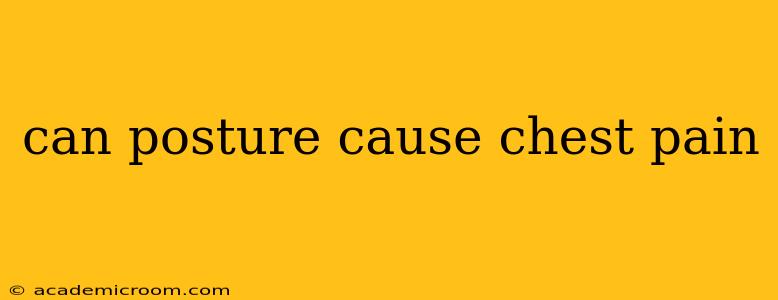Poor posture can indeed contribute to chest pain, although it's rarely the sole cause of serious chest pain requiring immediate medical attention. Understanding the connection between posture and chest pain is crucial for identifying potential problems and seeking appropriate treatment. This article will explore this relationship, addressing common questions and concerns.
How Can Bad Posture Lead to Chest Pain?
Poor posture, particularly slouching or hunching, can impact various parts of your body, leading to musculoskeletal issues that manifest as chest pain. The primary mechanisms include:
-
Muscle Strain and Tension: Prolonged poor posture strains muscles in your back, neck, and shoulders. This tension can radiate to your chest, causing discomfort, tightness, and even sharp pains. The muscles most often implicated are the pectorals (chest muscles), trapezius (upper back), and latissimus dorsi (lower back).
-
Rib Cage Restriction: Slouching restricts the rib cage's natural movement, limiting your breath capacity and potentially causing intercostal muscle pain (the muscles between your ribs). This restricted breathing can also exacerbate existing conditions like anxiety, leading to chest tightness and discomfort.
-
Referred Pain: Pain originating from other areas of the body can be felt in the chest. For example, poor posture contributing to spinal misalignment can cause pain in the neck or upper back that's felt as chest pain. This is known as referred pain.
-
Increased Pressure on Nerves and Organs: Poor posture can put pressure on nerves in your spine and even indirectly affect organs in your chest cavity. This pressure can manifest as chest pain or discomfort.
-
Exacerbation of Existing Conditions: If you have pre-existing conditions like costochondritis (inflammation of the cartilage connecting your ribs to your breastbone), poor posture can worsen symptoms and increase pain levels.
What Types of Chest Pain Are Related to Posture?
Posture-related chest pain is typically characterized by:
- Aching or tightness: Often described as a dull, persistent ache or a feeling of tightness in the chest.
- Sharp pain with movement: Pain may worsen with specific movements, such as twisting, reaching, or bending.
- Pain that improves with postural adjustments: Correcting your posture often provides some relief.
- Pain that is localized to the chest or upper back: The pain is usually centered in the chest region or upper back, sometimes radiating to the shoulders or neck.
Is Chest Pain from Bad Posture Serious?
While posture can cause discomfort and pain, it's crucial to differentiate between musculoskeletal pain and chest pain stemming from a more serious underlying condition, such as a heart attack. If you experience sudden, sharp chest pain, especially accompanied by shortness of breath, sweating, or nausea, seek immediate medical attention. These symptoms could indicate a life-threatening cardiac event.
Can a Chiropractor Help with Chest Pain from Posture?
Yes, a chiropractor can be helpful in addressing chest pain related to poor posture. Chiropractors focus on spinal alignment and musculoskeletal issues. They may use adjustments, manual therapy, and exercises to improve posture, reduce muscle tension, and alleviate pain.
How Can I Improve My Posture to Reduce Chest Pain?
Improving your posture requires consistent effort and practice. Here are some key strategies:
- Maintain good posture throughout the day: Be mindful of your posture while sitting, standing, and sleeping.
- Strengthen your core muscles: Strong core muscles support your spine and improve posture.
- Stretch regularly: Stretches targeting the chest, back, and shoulders can relieve muscle tension.
- Use ergonomic furniture and equipment: Ensure your workspace is set up to support good posture.
- Practice yoga or Pilates: These activities improve flexibility, strength, and body awareness.
When Should I See a Doctor About Chest Pain?
Consult a doctor if:
- Your chest pain is severe or persistent.
- The pain is accompanied by other symptoms like shortness of breath, sweating, or nausea.
- Over-the-counter pain relievers don't provide relief.
- Your chest pain is interfering with your daily activities.
This information is for general knowledge and does not constitute medical advice. Always consult with a healthcare professional for any concerns about your health. They can accurately diagnose the cause of your chest pain and recommend the appropriate treatment plan.
